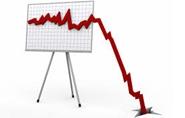SMU Data and Models

SMU MoMo Index Shows HRC Negative Price Trend for 10th Week
Written by Brett Linton
October 29, 2014
The Steel Market Update Price MoMo Index for flat rolled steel in the U.S. indicates hot rolled coil price momentum continued its downward trend for the tenth week in a row. MoMo, which is a trailing indicator, is measured as a percentage and shows the relation of the current hot rolled coil (HRC) price movements against the previous 12-week average spot price as recorded by Steel Market Update. MoMo was measured at -4.00 percent this week, meaning that the current HRC price is lower than the average price over the last 12 weeks.
The change in MoMo can be a useful indicator in depicting the severity of price movements and evaluating the directional trend for flat rolled steel pricing. The week-over-week change in MoMo was -0.97 percent, following a +0.43 percent change the week before. Looking at this change on a 3-week moving average, we see the trend for HRC prices is negative for the ninth consecutive week. The 3-week average change in MoMo is -0.56 percent, up from -0.41 last week.
The interactive graph below demonstrates the relationship between the SMU hot rolled coil price and the three week moving average change in MoMo. Published in our Tuesday evening issue, the SMU HRC price range for this week is $610-$650 per ton with an average price of $630, down $10 from one week ago.
SMU Note: You can view the interactive graphic on our Price MoMo Index below when you are logged into the website and reading the newsletter online. If you have not logged into the website in the past and need your username and password, contact us at info@SteelMarketUpdate.com or 800-432-3475. If you need help navigating the website we would also be very happy to assist you.
{amchart id=”70″ SMU Price MoMo Index}

Brett Linton
Read more from Brett LintonLatest in SMU Data and Models

SMU Scrap Survey: Sentiment Indices rise
Both current and future scrap sentiment jumped this month, though survey participants reported responses before key trade news was announced.

SMU Survey: Sentiment splits, buyers have better view of future than the present
SMU’s Steel Buyers’ Sentiment Indices moved in opposite directions this week. After rebounding from a near five-year low in late June, Current Sentiment slipped again. At the same time, Future Sentiment climbed to a four-month high. Both indices continue to show optimism among buyers about their company’s chances for success, but suggest there is less confidence in that optimism than earlier in the year.

SMU scrap market survey results now available
SMU’s ferrous scrap market survey results are now available on our website to all premium members. After logging in at steelmarketupdate.com, visit the pricing and analysis tab and look under the “survey results” section for “ferrous scrap survey” results. Past scrap survey results are also available under that selection. If you need help accessing the survey results […]

SMU flat-rolled market survey results now available
SMU’s latest steel buyers market survey results are now available on our website to all premium members. After logging in at steelmarketupdate.com, visit the pricing and analysis tab and look under the “survey results” section for “latest survey results.” Past survey results are also available under that selection. If you need help accessing the survey results, or if […]

SMU Survey: Sheet lead times stabilize, plate contracts
Mill lead times for sheet products were steady to slightly longer this week compared to our late June market check, while plate lead times contracted, according to steel buyers responding to this week’s market survey.
